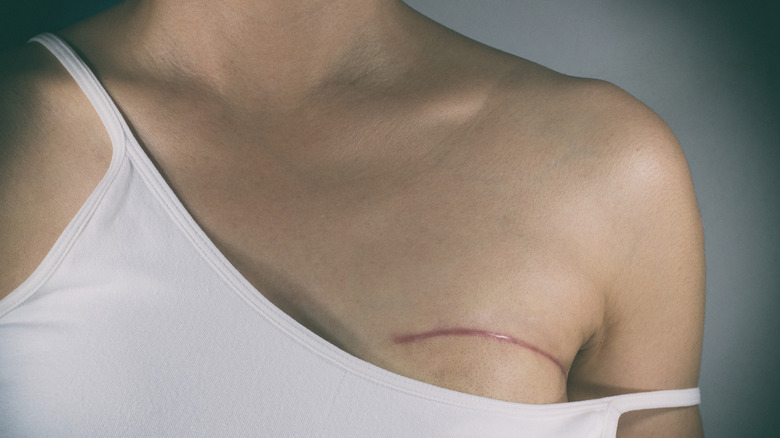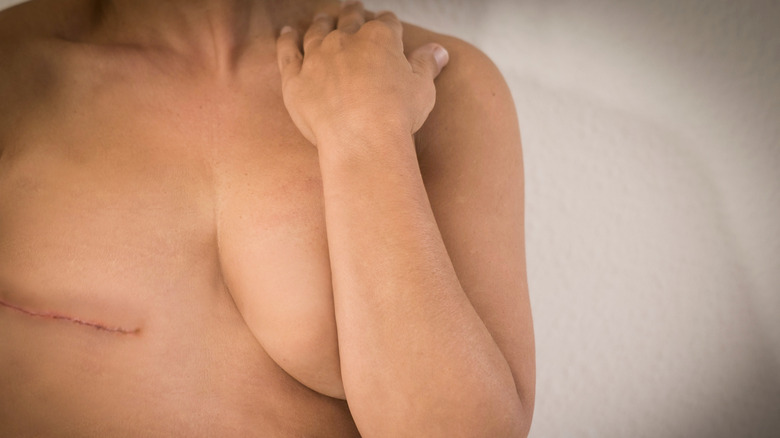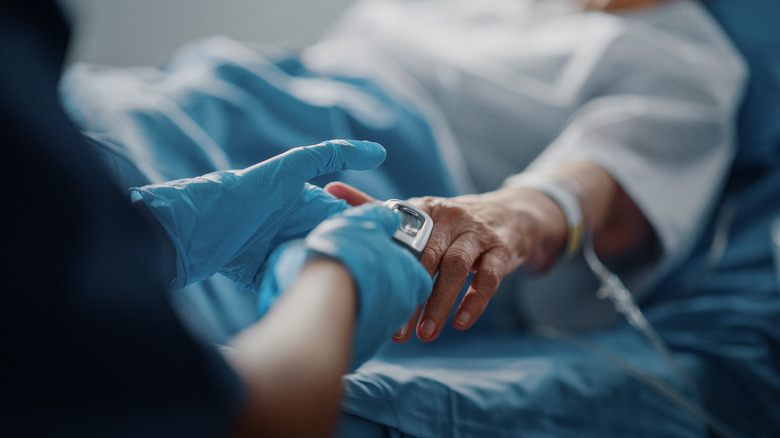What To Expect After Having A Mastectomy, According To A Leading Breast Surgery Specialist
This year, 287,850 women in the United States alone will have the harrowing experience of being diagnosed with breast cancer (per American Cancer Society). And statistics show that over the course of their lives, one out of every eight women will have to make an important decision about what kind of life-saving treatment they will receive. According to the Centers for Disease Control and Prevention, there are a few routes women can take, including hormonal therapy, chemotherapy, radiation, biological therapy, or surgery.
There are two different surgeries commonly used to remove breast cancer tissue: breast-conserving surgery, in which only the part of the breast affected by cancer is removed, and mastectomy (per American Cancer Society). Dr. Lucy Maria De La Cruz, Chief of Breast Surgery at MedStar Georgetown University Hospital explains, "Mastectomy is the surgical removal of 98% of breast tissue."
In an exclusive interview with Health Digest, Dr. De La Cruz explains the different types of mastectomy and details what women who've had one can expect throughout the process.
The different types of mastectomies
While mastectomies across the board seek to remove nearly all breast tissue, there are different types that can spare or remove different parts of the breast, depending on where the cancer has spread. "Amongst mastectomy, we have different types," says Dr. De La Cruz. "A modified radical mastectomy removes the entire breast — including the breast tissue, skin, areola and nipple — and most of the underarm (axillary) lymph nodes.The simple (skin sparing) mastectomy removes the breast tissue, nipple, areola and skin but not necessarily any lymph nodes need to be removed. A nipple sparing mastectomy removes the breast tissue, leaving the nipple, areola and skin intact and again not necessarily any lymph nodes."
Dr. De La Cruz explains that the kind of mastectomy you may need is contingent on a few factors. "Patients who are genetic mutation carriers for increased risk of cancer are candidates for mastectomy without any lymph nodes removed. They can have [a] nipple sparing mastectomy, as it has been shown to be oncologically safe. Other patients who may need mastectomy as part of their treatment are patients with inflammatory breast cancer or locally advanced breast cancer. These patients need a modified radical mastectomy. Other breast cancer patients may need mastectomy if [the] tumor to breast ratio does not allow them to have breast conservation surgery (lumpectomy) and for those patients who have breast cancer and choose to have mastectomy as part of their surgical treatment."
What to expect post-op
While having a mastectomy can be scary and overwhelming, sometimes knowing what to expect can quell some of that fear and anxiety. For many people who've had major surgery, often the first question is, "When do I get to go home?" When it comes to mastectomy, Dr. De La Cruz says, "Hospitalization depends on your institution and surgeon." She points out that whether or not you've had reconstruction surgery — as well as the type of reconstruction you may have had — can also play a role in the duration of your hospital stay.
"At Medstar Georgetown University Hospital, patients who undergo mastectomy without reconstruction or with implant/tissue expander reconstruction go home the same day. For those with autologous tissue (own tissue) reconstruction such as DIEP (deep inferior epigastric pedicle) they usually stay 1-3 days in the hospital," she explains.
Whenever you are ready to leave the hospital, BreastCancer.org assures that your surgeon or nurse will supply you with written instructions on how to take care of yourself at home.
The recovery process
When it comes to the physical recovery of a mastectomy, Dr. De La Cruz says, "Recovery is usually 4-6 weeks of no heavy lifting. Patients will have drains to remove extra fluid the body will produce during recovery, and will see the plastic and/or breast surgeon during that period for follow up." Dr. De La Cruz says that the return to normal activities can happen, "Once the patient has been cleared by their surgeon — usually at 6 weeks."
Like with any surgery, there is the possibility for complications to occur after a mastectomy. Dr. De La Cruz says these can include, skin or nipple necrosis — or the loss of skin or nipple due to low blood supply — bleeding, scarring, asymmetry, chest wall numbness, post-mastectomy pain syndrome — or phantom pain — and swelling. She also notes that while the chances are small, there is also a 3% chance of infection. Reconstruction can come with its own set of complications. "From the reconstruction it can be implant infection, capsule contracture, [or] clotting of vessels from DIEP reconstruction," says Dr. De La Cruz. However, she clarifies, "This type of complication is rare, especially in highly specialized centers like ours where our plastic surgeons perform these on a daily basis."




